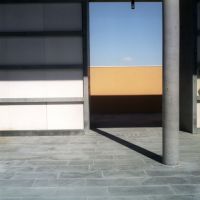Krista Mölder and the pleasure of visual text
Elnara Taidre (1-2/2010)
Elnara Taidre analyses Krista Mölder’s photographic exhibition
This article considers the photography of Krista Mölder and her recent solo exhibition Boredom Is Not Far From Ecstasy in the broader context of Mölder’s work, its relations to issues concerning the relationship between visual art and theory, and the communicative potential of art. The autonomy of visual art does not imply that it must become hermetic; rather it indicates art’s potential to directly relate to the viewer via perception, communicating a message without necessarily being supported by ideas and theories in the form of text. The virtue of Krista Mölder’s works lies in the fact that, regardless of the author’s theoretical ‘baggage’, her photographs are not simply a direct translation into visual language of the text that inspired them – they successfully evade any one-to-one correspondence with the literary or theoretical.
Viewers may naturally associate Mölder’s photographic compositions with the texts of Roland Barthes, Gaston Bachelard, Viktor Shklovsky or Henri Lefebvre. The artist has taken these theorists as a starting point, although theoretical associations have not been violently imposed upon the images. The name of a relevant philosopher may remain unmentioned; it is not what defines the content of the works, and the accompanying text does not play a central role in the exhibition. While they maintain their conceptual – and, in the case of her best series, philosophical – nature, in their visual self-sufficiency Mölder’s photographs are far from being a mere illustration of theories – a tendency that can be rather annoying in a certain type of contemporary art. Ideas are presented here in a sufficiently elaborated and generalised way. In this way they may function less specifically, no longer being associated necessarily with any single source.
At the same time, this need not imply that Mölder deliberately intends an ideal of pure and autonomous art, programmatic anti-narrative or other modernist mythology. Her intellectual works address the viewer, asserting the need to work through several things and to bring them all together through the photographic medium or narrative. Her major themes are time, space and our perception of them, chronotope, signs and the creation of meaning. Mölder’s approach may be characterised as phenomenological: she regards the subjective sense of space and time as being of primary importance, bringing this to the surface in a series of absurd moments (Landmarks, 2006–2007) or by mapping a particular space (Inside Tracks, 2006).
Mölder had already abandoned staged photography soon after completing her BA project. She simply ‘picks up’ frames for her images or deliberately heads for places where she might find a situation she needs, without personally interfering with that situation, as was the case with the image featuring a row of plates in the exhibition Boredom Is Not Far From Ecstasy – the author visited several restaurant kitchens while trying to find this motif. Increasingly, she aims to make present in the image her gaze as photographer, using it to prompt the same sense of presence in the viewer. At the exhibition Surface/Bird, in 2009 in Artdepoo Gallery, a site-specific work, with surreptitious playfulness, unfolded itself to viewers precisely through their presence in the gallery space, observing the exhibited image. Several photos in Boredom Is Not Far From Ecstasy have been constructed to offer viewers a direct insight into the frame: the foreground seems almost tangible, and the background too has a strong visible presence.
Important themes such as chronotope have determined the serial principle of her work. Besides the common theme of the works in each series, the individual images complement one another in such a way as to suggest that they cannot properly be viewed separately. This results in peculiar diptychs expressing a single idea via two inseparable compositions (Landmarks). Although the artist herself has recently sought to give greater autonomy to each of her works, there are also conceptual groupings of photographs in Boredom Is Not Far From Ecstasy. The division of the works into groups, which may sometimes occur unintentionally, is based on the structure of the pictures: recognising the loose similarity in compositional features helps to reveal a general idea that draws precisely on those visual elements. The shelf, the row of plates, the architectural construction or the window frame: images that might seem very different at first sight have a common character that is not simply their minimalist aesthetic (highlighting certain basic structures and general principles by ‘clearing’ the view). In each of these images there is an organising grid structure that creates a special sense of order and equilibrium.
However, the ‘boredom’ indicated by the exhibition title does not adequately describe the state that is achieved by these photographs; rather, it is ‘leisure’ – a calm and peaceful moment to take time out, as if stepping out of the continuous, linear flow of time. It is in this way that the moments that usually pass unnoticed may appear to us in their significance: random views, spatial structures and ornaments with a special, multi-layered logic about them. Shklovsky’s principle of estrangement and Lefebvre’s meta-philosophy of daily life are summarised here in the form of a simple principle that is nonetheless difficult to apply with any continuity: the principle of valuing everyday moments and being able to see the extraordinary in what is ordinary.
Elnara Taidre is an art historian and critic; she currently pursues her PhD studies in art history at the Estonian Academy of Art and works in the Art Museum of Estonia.

Draakon Gallery
21.12.2009–9.01.2010
< back

